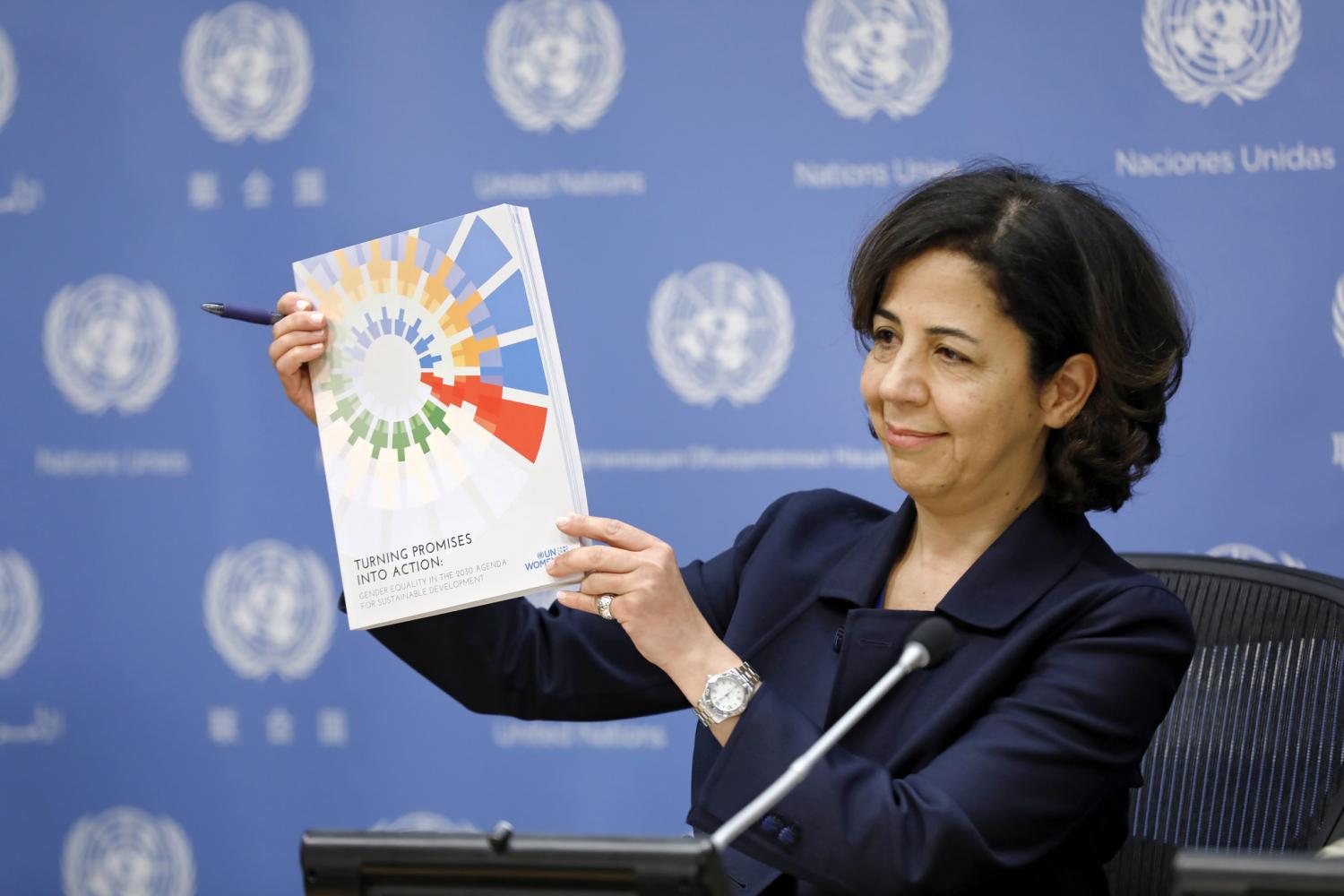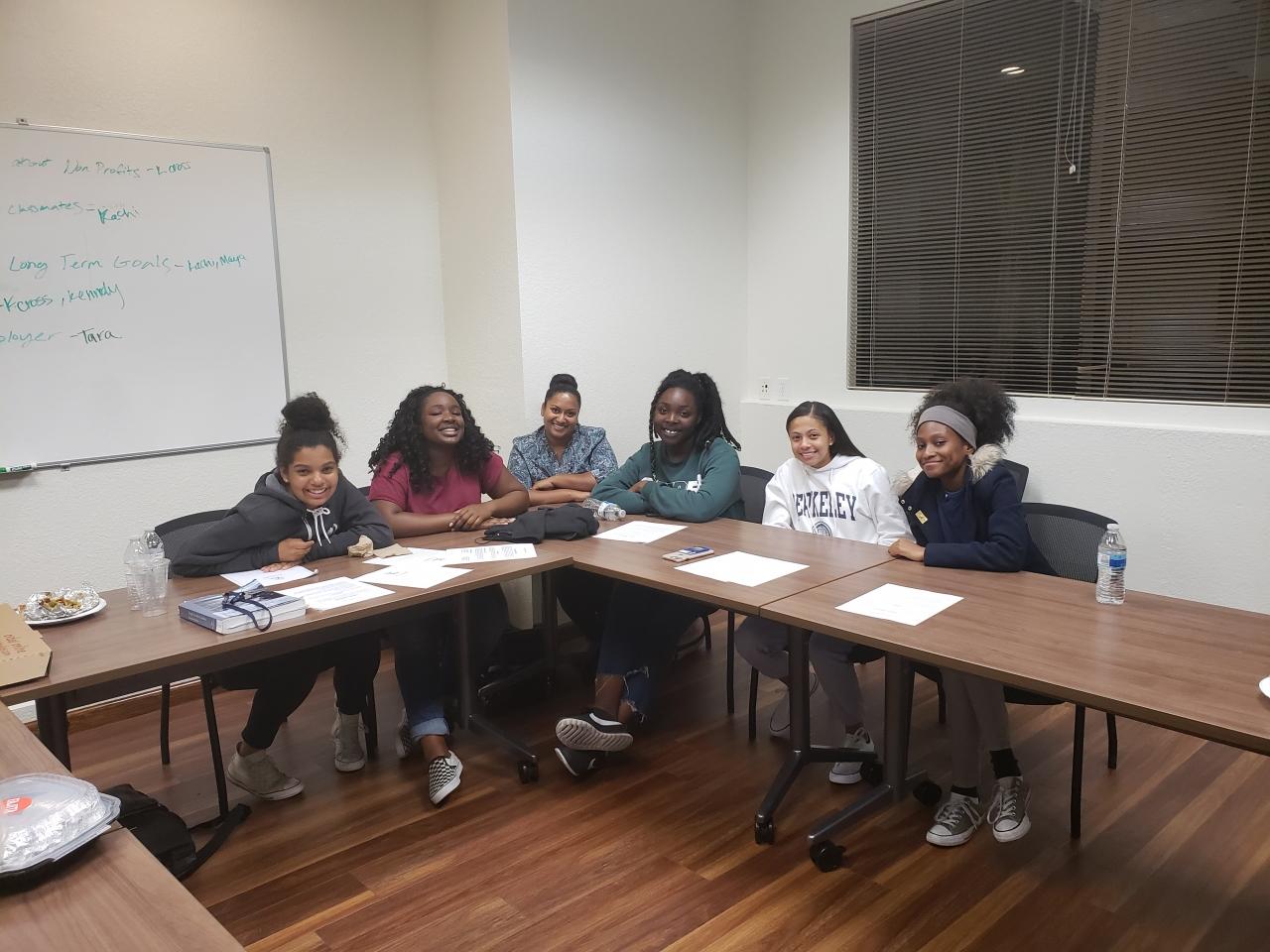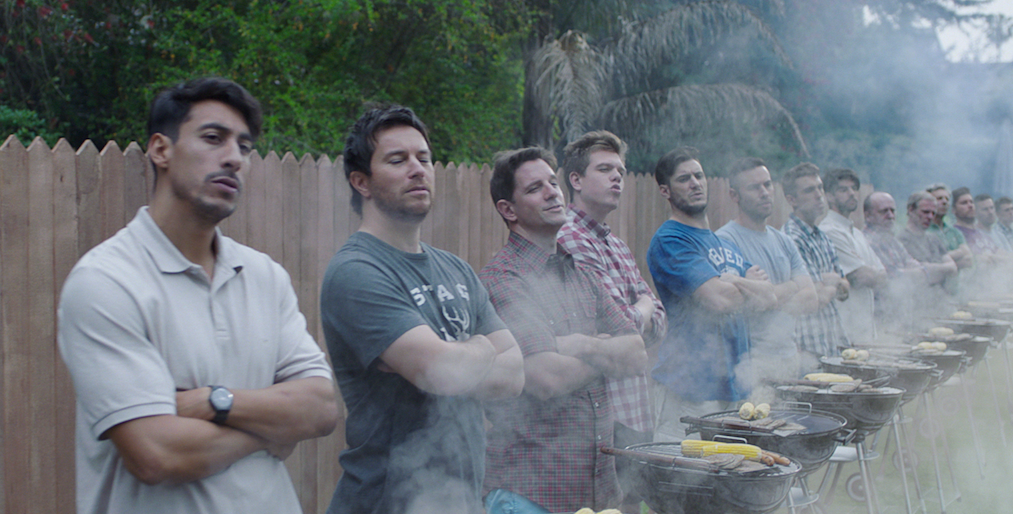Our Company is Two-Thirds Women. Here’s Why That Makes Us Successful.


#RealTalk only works when it’s followed by #RealAction. So when we started the Real Talk Lunch Series at Aflac for women in the IT group to gather and frankly discuss their workplace experiences, we made sure senior female executives were there. I was one of those executives and it was an eye-opening experience for me.
By sitting in on those sessions, I learned which issues to raise up and champion on behalf of the women in our workforce. I’m happy to report we’ll be expanding the program to the entire company later this year.
We’ve been able to attract and retain a strong female workforce at Aflac by thinking big but acting from the ground up. Our workforce is made up of 67 percent women, roughly half of whom are minorities. With such a heavily female workforce, we’re constantly striving to move toward gender equality across the board, from equal pay to equal opportunities. We’re at parity on pay (in fact, female employees are paid as well or slightly above the midpoint for a given salary range) and 35% of our senior leadership team is female.
What’s at stake?
A report out of McKinsey Global Institute found that increasing gender equality in the workforce could add $12 trillion to global growth by 2025. And if women matched men equally in terms of labor market roles—what McKinsey calls the “full potential” scenario—the global annual GDP could grow by $28 trillion by 2025. Understanding that number means coming to terms with all the ways in which women are undervalued across the global workforce, underrepresented across all levels of industry, and lacking in support from their employers.
Here at Aflac, we’ve been working toward the full potential scenario for years—and we’re much better for it.
We offer on-site child-care facilities—an important and oft-forgotten benefit for working parents—provide corporate training to help employees learn on the job and set themselves up for future opportunities and take the time to listen to our employees’ feedback and experiences. All that and more are part of what makes us one of the best places to work, named so by Fortune for the 20th consecutive year.
There’s still a lot to do, but we’re proud of the progress we’ve made.
Aflac is powered by a diverse workforce. That means that policies that help women, help our company. Global progress that helps women move forward in business, helps our business. Here at Aflac, when women win, we all win.
3BL Media is proud to have had Catherine Blades as one of the emcees during 3BL Forum: Brands Taking Stands last October. We're currently seeking proposals for speakers at the next 3BL Forum, October 29-30, 2019, at MGM National Harbor, just outside Washington. D.C. Click here learn more on how to submit a proposal to be a part of this event designed for forward-thinking companies.
Previously posted on LinkedIn and on 3BL Media news.
New Standard to Drive Global Finance Closer to the SDGs


Impact investing is increasingly expected to close a looming funding gap to achieve the United Nations Sustainable Development Goals (SDGs). According to the U.N., achieving the SDGs by 2030 will require a total annual global spend of $5 trillion to $7 trillion, with an investment gap in developing countries of about $2.5 trillion. But how do the investors who are willing to step up to the plate know that their money is driving real impact?
Today, the non-profit organization Verra launched the “Sustainable Development Verified Impact Standard,” or SD VISta for short. SD VISta sets out rules and criteria for the design, implementation, and assessment of projects that aim to deliver sustainable development benefits. Under SD VISta, projects must demonstrate to the satisfaction of a third-party assessor that they advance the SDGs. The standard requires direct alignment with SDG targets.
“A standard like SD VISta can play an important role in having an independent assessment of SDG impacts and drive funding towards high-impact projects,” Julie Baroody, Director of Standards Development at Verra, told TriplePundit.
Verra developed and manages the world’s most widely used voluntary greenhouse gas (GHG) program, the Verified Carbon Standard (VCS). Baroody says she has seen the private sector lead innovation in the carbon space and expects that “the private sector and impact investing can have the same kind of effect with the SDGs.”
Growing demand for transparency
A recent report from research house Cicero found that 97 of the 100 independent and restricted financial advisors surveyed said that they were either “very concerned” or “fairly concerned” about the potential for ESG (environmental, social and governance) products to be mis-sold to them.
And as Huw van Steenis, a senior adviser to the governor of the Bank of England, recently noted in the Financial Times, the lack of high-quality metrics is a chief obstacle in asset managers adopting ESG principles.
“We need to avoid misleading claims around SDG contributions,” Baroody says, “Our standards are a credible way to say that this is a legitimate project with a verifiable impact.”
Turning SDG leadership into traded products
The need for more transparency and clear labeling around ESG products is also driving a trio of exchange-traded funds (ETFs) from Impact Shares, which helps organizations translate their social values into an investable product traded on the New York Stock Exchange.
The latest addition, launched last September, is the Impact Shares Sustainable Development Goals ETF, which tracks the Morningstar Societal Development Index.
According to Ethan Powell, CEO of Impact Shares, the fund is designed to provide exposure to companies worldwide with strong policies and practices relative to the SDGs that are actively engaged in the world’s poorest countries, known also as the 47 Least Developed Countries (LDCs).
“We act as a capital bridge to social advocacy causes,” Powell told TriplePundit. “Our social screens are public and very transparent. We provide companies with the ability to understand what is expected from them as corporate citizens from credible social advocacy groups related to important social issues.”
The other two ETFs from Impact Shares reflect collaborations with the NAACP and the YWCA. The former, which began trading in July 2018, is the first of its kind in that investors can allocate money to the companies that have a track record of supporting the NAACP’s vision for corporate America. The latter, launched in August, allows investors to deploy capital in companies that have aligned their business practices with the women’s empowerment standards of the YWCA and nonprofit research firm Equileap.
A game of catching up
The SDGA fund has been well received, Powell says, “particularly in Europe, where they are a little ahead of the game. The challenge with the SDGs is that the goals are not written rules for ESG investment fund managers. They are broad aspirational goals designed to reach several constituencies and audiences. With the help of the United Nations Capital Development Fund and Sustainalytics, we synthesized a system of social screens.”
The impact investing firm Swell Investing requires that each company it includes in its portfolios must have revenues aligned with at least one of the SDGs. According to Jake Raden, Impact Analyst with Swell Investing, the team conducts a deep dive analysis of the company’s business practices and then uses a proprietary process to ensure those revenue-generating activities align to specific SDG subgoals.
Like Impact Shares, the emphasis is on transparency. “On the platform you can see exactly which companies are in each portfolio and details of what it does to align with the SDGs,” Raden told TriplePundit. “If you don’t agree that one of the portfolio companies is actually driving towards positive progress, then you can simply exclude it from your Swell ‘mix.’ We allow investors to exclude up to three companies from their overall Swell mix. “
An ongoing journey
Whether these new standards, funds and platforms will help drive more ESG investment towards the SDGs remains to be seen.
“I think institutional investors get it,” Powell says. “They appreciate the position the U.N. took in 2015, but it takes time to apply their goals into actionable investment strategies. The awareness about the SDGs among the general public is still in its nascent stages but it will eventually spread to the general investing public as the SDGs become more familiar.”
The investment community itself certainly recognizes that it has to walk the talk when it comes to creating forward momentum for the SDGs. Refinitiv, a leading financial market data firm, recently pledged support for the SDGs. The company pledged to be carbon neutral by 2020 as well as reach a minimum of 40 percent female representation in senior leadership roles globally.
“As well as driving changes in investment behavior through our data and insights, this also means caring about our own operational footprint,” David Craig, CEO of Refinitiv, recently announced. “We are increasingly harnessing our core capabilities to drive positive social impact, being smarter with our resources and footprint, and balancing short-term considerations with long-term progress.”
Image credit: United Nations Women/Flickr
The Outlook for Social Enterprises in 2019 and Beyond


U.K.-based One Good Thing partners with Elvis & Kresse, which makes accessories from worn out fire hoses
Social enterprises are a growing force in the global economy and a fierce catalyst for social change. One third of startups globally have social good as their core mission. In the United Kingdom, the startup rate for social enterprises is three times that of mainstream small and medium-sized enterprises (SMEs).
Social businesses focus on providing market-driven solutions that address a social, economic or environmental problem. One Good Thing, for example, sells high-end gifts made from recycled material while empowering the livelihoods of artisans that have made them; Alterna is a non-profit accelerator for social businesses in Guatemala; and MUrgency is an online platform in India that connects people who need emergency medical help with the closest doctor, ambulance, paramedic, nurse or hospital emergency room in 15 cities. Conversations with the founders of these companies and insights from a few others provide an outlook into the future of this space.
The fact is, most social enterprises will stay small, but still nimble
Despite the growth in number of social enterprises over the last few decades, like any new business, scaling is difficult. Social impact management consultant Lynn Thurston believes that moving forward, the call for scaling social businesses will lessen as governments and investors acknowledge that many enterprises will simply remain small, or niche.
How does “not-scaling” affect the competitiveness of a business? It means the company cannot reduce the price of its products without losing revenue. Although there is a notable shift in consumer mindset as they increasingly demand companies to be socially responsible, the decrease in disposable income during economic slowdowns reduces the inclination to buy social products, says Michael Cooke, co-founder of One Good Thing.
“For example, everyone will support the idea of a fairly traded t-shirt where part of the proceeds goes back to the community in which it is made, but when times are tough and there is a choice to be made between that t-shirt and the much cheaper, mass-produced alternative, people will still opt for the quick satisfaction of a bargain” explains Cooke. “It means that the job of social enterprises will be to highlight the additional value in the socio-environmental benefit that justifies the extra cost.”
In emerging markets like India, scaling may not be an issue: “With over a billion people facing diverse issues, India has become a hotbed for social entrepreneurship,” says Sweta Mangal, co-founder and director of MUrgency. “With an estimated two million social enterprises, India has enough socio-economic challenges that require attention, and investors are coming forward to help scale innovation in the social sector.”
More corporations will enter the social impact space
“More companies will enter the social impact space as environmental pressure on their industry intensifies. For example, the global movement to ban or limit single-use plastics, along with China's recent decision to no longer accept plastic waste, will generate new products and unleash more aggressive clean-up efforts,” says Thurston.
Michael shares the same view: “We will see a lot more activity from bigger companies because of the positive response that initiatives such as the Adidas UltraBoost trainers made from ocean plastic, and the Sky News ‘Ocean Rescue’ campaign. Long may this trend continue because it is these companies that ultimately have the clout to make the big changes.”
In 2017, Adidas sold one million pairs of shoes made with ocean plastic; each pair used 11 plastic bottles. Sky News has committed to invest £25 million over five years in social ideas that tackle the plastic pollution problem.
“We´ll see more activity of established traditional companies adapting practices to introduce impact models within their original business models,” says Daniel Buchbinder, founder of Guatemala based social enterprise accelerator Alterna. “We will begin to see more cases of corporations having mergers & acquisitions, or joint ventures with impact driven businesses.”
Continued rise of B Corps
Consumer demand for increased emphasis on social and environmental values has resulted in the establishment and rise of B Corporations - businesses that meet the highest standards of verified social and environmental performance, public transparency, and legal accountability to balance profit and purpose. Warby Parker, Danone North America, Patagonia, Natura, Etsy and Ben & Jerry’s are some examples. Today there are over 2,655 certified B Corporations across 150 industries in 60 countries.
Research by B Corp shows that its members in the U.K. have experienced an average year-on-year growth rate of 14 percent, 28 times higher than the national average, and B Corp-certified consumer goods brands grew on average 21 percent in 2017, compared to a national average of 3 percent across their respective sectors.
Change in funding models
In addition to grants and donations, social enterprises will start seeing more impact investments to help them scale. Over the next five to 10 years, such blended finance models will become business as usual, says Ryan Little, co-founder of the Canadian charitable giving platform CanadaHelps, and project manager at the BMW Foundation.
Daniel Buchbinder concurs: “Impact investing is having exponential growth in Latin America. Also, international aid has taken solid steps to position themselves as impact investors and key actors in the social enterprise ecosystem. This should be a big booster for the sector due to their influence especially in Central America and the Caribbean.”
Public-private partnerships will also come together to fund social causes, as demonstrated by Sky News teaming up with government on their Ocean Rescue innovation fund where they will match £2 million in grants to companies that receive investment from Sky Ocean Ventures.
Increased engagement with governments
We can expect to see socially focused businesses collaborate more with governments to achieve systemic change.
“Now, many social entrepreneurs aren’t asking anymore whether they should work with government, but rather how. If you think of solving a problem on a national level, you cannot avoid or escape public institutions as key partners,” says Katherine Milligan, Director and Head of the Schwab Foundation for Social Entrepreneurship.
“India with its various issues and with the population not confident in the political leadership is now relying more on business to solve the key issues, so I think the role of social enterprises in India will become more important over time,” says Mangal.
Impact of technology and access to big data
A new report by Deloitte on the rise of the social enterprise discusses how technological advances in artificial intelligence (AI), machine learning and big data will present new opportunities for businesses to have a positive impact on society. This technology is fundamentally changing how work gets done, who does it, and how it influences society, and will open up new opportunities for businesses to have a positive impact on society.
Thurston believes that the cost of data will continue to fall which will help social impact entrepreneurs design information and financial services more accurately tailored to the needs of disadvantaged communities.
Whether social enterprises will thrive, or if larger corporations become more socially responsible, what remains without a doubt is that the future of businesses depends on their ability to have a triple bottom line, whether they are classified as a social enterprise or not. New partnerships, market-driven products, technology and funding models will help drive the social business agenda.
Image credits: One Good Thing/Facebook
It’s Time to Take Control of Your Data: 3 Easy Ways to Own Your Online Presence


This article series is sponsored by Symantec and produced by the TriplePundit editorial team.
You might be asking yourself what ‘taking control of your data’ really means or why it’s important. As the COO of Norton LifeLock, I often hear “I’ve got nothing to hide on my phone” and “I don’t care who sees my browser history." I quickly point to the 143 million Americans who were affected by cybercrime in 2017; that’s more than half of the U.S. adult online population.
The scariest part is that most people have no idea how much personal information they are giving away. We leave a trail of data whenever we visit a website, use an app, check email or play a game online. Browsers collect our search history, phones store the locations of places we go. This data has a high value.
Sharing data can make apps better—search results are more relevant and the ads you see are for products you might actually buy—but this comes at a cost. The price of many of these personalized services is our personal information—it is collected and analyzed, can be sold, and can be stolen. We need to make sure we’re choosing how, when and where our data is being used.
When data isn’t private: Identity theft and how what we share can last a lifetime
There is a new victim of identity theft every two seconds. Keeping your data private also means keeping it away from misuse. With just three pieces of personal information from the Web, your identity can be stolen. Perhaps your email address is listed in an app you use, your birthday is in your Facebook profile, and your maps app knows your home address. If so, those three things can be stitched together to open credit cards in your name, to rack up medical bills for services you never received, or to claim wages you didn’t earn.
According to the Federal Trade Commission (FTC), in 2017 U.S. consumers reported losing a total of $905 million to fraud, and worldwide 16.7 million people were identity theft victims. One of our members signed up for LifeLock Ultimate Plus as a precaution after a breach notification he received from an ex-employer. A year later, he began receiving alerts for accounts opened using his personal information at Verizon Wireless, Visa, Walmart, JC Penney and others. As we worked to restore his identity, the Salt Lake City Police Department noticed our fraud alerts and connected them to a man pulled over for a DUI using a fake ID and credit cards with our member’s information on them. The man was arrested and charged with multiple crimes, and Norton LifeLock paid for all of the legal fees and restoration expenses for our member.
Identity theft can destroy your credit and prevent you from buying a home or leasing a new apartment. It can hurt your job prospects as employers routinely look at credit history, keep your kids from getting financial aid, and can take years to clean up. Keeping data private and secure prevents the amount of time, money and stress that goes into getting one's identity back.
Make sure you share with care. Having your private life exposed can also be embarrassing, and it can negatively impact your life. We all have things we don’t want public—how much money we make, photos from years ago, joking texts we send friends that could be misunderstood.
You might not have a lot to risk now, but what about 20 or 30 years from now when this information is still out there? Social media posts have affected people’s job prospects and teens’ abilities to get into college, while leaked emails have cost both politicians and business executives their jobs.
In addition to possible embarrassment, sharing sensitive personal data, such as race, religious beliefs, sexual orientation or electronic medical records, can lead to discrimination. Even more importantly, for victims of domestic violence, political activists, human rights activists and even public figures, data privacy helps ensure their families and homes are safe.
Three easy ways to start taking control of your data
The abundance of information sharing may seem daunting, but these simple steps can help you begin to own your online presence.
1. Check your settings, and understand your digital footprint. Check and then tailor your privacy settings on your computer, phone, social media accounts and other apps. You can revoke third-party app permissions at any time in your settings. Blocking any unnecessary access to your photos, your location, and even your contacts list can add a layer of security, give you a firm handle on your online reputation, and also speed up your device and extend the battery life once such services are no longer running in the background.
2. Use tools to protect your privacy. Customize the privacy settings in your browser; use a throwaway email account to sign up for a new service; use a password manager to create, store, and manage your passwords, credit cards and other sensitive information; and utilize tools that block access or alert you to suspicious requests from apps or programs on devices. At Norton LifeLock, we are introducing a new online privacy product to test in the market, Norton Privacy Manager. This all-in-one app brings many online privacy solutions into a single app and helps manage and control what personal information you share online. With Norton Privacy Manager, you can access private virtual phone numbers, emails, private conversations, a password manager and more, including an in-app secure browser.
3. Be careful on public Wi-Fi, and use a VPN. Hackers and thieves can easily eavesdrop on public Wi-Fi hotspots and open wireless networks. A secure VPN (Virtual Private Network), such as Norton Secure VPN, can help protect users’ private information when connected to Wi-Fi by encrypting all of their internet traffic, potentially protecting them from these attacks.
And, if your identity has been compromised, get help quickly. The most important thing to remember about your privacy is that it is YOURS. It is your information, your habits and patterns, and your actions—and you have the right to keep that private.
Images courtesy of Symantec
Follow the Money: Sustainability Goes Mainstream


In the last two decades, sustainability reporting has gone from an exercise for the largest companies to a necessity to attract investors and meet local and international regulation. But the main benefit of sustainability reporting remains that companies best understand their impacts and can improve their bottom line along with the world around them.
The origin story
Founded in the wake of the Exxon Valdez oil spill in 1989, the Coalition on Environmentally Responsible Economies (Ceres) answered the call to shine a light on corporate behaviors by demanding companies report on their impacts. This helped launch the corporate transparency movement and led to the creation of a body tasked with setting the framework for disclosure, the Global Reporting Initiative (GRI) in 1997. Over the next twenty years, voluntary disclosure of sustainability information has gone from a niche to the mainstream.
A niche no longer
Like all movements, it started slowly. As you might imagine, companies were not initially lining up to report on their impacts to people and the planet. Fast forward to today…now more than 90 percent of the world’s largest companies report on their environmental, social and governance — or ESG — information. And the growth rate has been rapid — just a few years ago (2011), only 20 percent of S&P 500 listed companies reported this information — today it’s 85 percent. Clearly ESG reporting is now commonplace — at least among larger companies. And while this movement is still maturing, there is a lot of consistency in the information being reporting. As of 2017, 75 percent of the world’s largest companies rely on the GRI standards for these disclosures.
Why has this trend accelerated so quickly?
The first driving force for ESG disclosure was reputation. With the hindsight of many corporate scandals, company leaders learned that responsibility is essential to their brand, their employees and the communities in which they operate.
While reputation is still a powerful force, it is no longer the only or the main driver. Increasingly, investors are demanding high quality ESG information. Recent studies have shown that more than 80 percent of mainstream investors (as distinguished from socially responsible investors) now rely on ESG disclosures for decision making. And the total assets under some form of ESG management has ballooned to nearly USD$23 Trillion — which exceeds the total size of the US economy.
The need for standards
Taking stock of the acceleration of ESG reporting and emerging trend towards adoption by the financial markets, GRI acted. Back in 2014, the organization revised its governance model to become a true standards setter. Financial markets rely on credible, high-quality, comparable information and, with its new model, GRI was able to develop a more rigorous process resulting in more detailed and comparable disclosure standards to meet these needs.
And the changes have been successful.
Today, 90 percent of the Spanish IBEX 35 listed companies use GRI for their ESG disclosures. The number in the French CAC 40 is 80 percent, and it’s 78% of the US Dow 30. And now capital markets are getting in the game. As of this writing, 55 capital markets around the world either reference or require GRI Standards for their listed companies to disclose ESG information.
ESG disclosure is a niche no longer — this information is increasingly used by financial markets around the world. And just like with financial information, a single disclosure standard is essential for global markets to communicate in the same language. This is GRI’s vision.
Challenges ahead
While the disclosure standards themselves have matured and are now broadly adopted throughout the world, some challenges in the use of the standards remain:
- Quality: The quality, timeliness and veracity of this information can vary widely which reduces confidence and thus reliability for decision-making. And although many reports now use the GRI Standards, only about 40% of ESG disclosures are assured by a third party.
- Comparability: Investors like to compare the results of one company against others. While this is difficult with financial information, it is tenfold more difficult with ESG disclosures. Financial information only deals with money. GRI currently offers 33 topic-specific disclosure standards on topics as disparate as diversity and climate change. These are obviously hard to compare. In addition, as companies choose which issues are “material” to them, they will report on different topics than peer companies. Alignment on how best to compare corporate sustainability information remains elusive.
- Small business reporting: While roughly 50% of economic activity and 90% of all companies fall under the definition of small and medium enterprises (SMEs), very few of these companies report ESG information. This is starting to increase, but more work is needed to simplify the process to make it more accessible to SMEs, considering the level of resources they can devote to reporting.
The need for policy
Many of these challenges can be solved through regulation. GRI is currently tracking around 450 ESG disclosure mandates in more than 60 countries. While these numbers continue to increase, there must be more consistency in the requirements. Harmonized ESG disclosure will depend on harmonized regulations and standards across the world. GRI offers the global solution for ESG disclosure standards, but multinational institutions like the United Nations, G20, OECD, The World Bank and others must play a key role in driving the needed regulatory changes.
In the end, it’s not about the report
The ultimate purpose of ESG information is to improve outcomes — financial, social and environmental (the so-called triple bottom line). Whether you are an investor, environmental or labor activist, media or just an interested bystander, ESG information provides essential insights into a company’s operations.
While we have some challenges ahead before ESG information is fully integrated into the mainstream, the change is underway. And as this trend progresses, we will begin to align investment with sustainable business practices. If we get this right, we will leave an even better world for our children and grandchildren.
Originally posted on 3BL Media news.
Image credit of London's financial district: Travel Junction/Flickr
Etsy Shows Leadership on Diversity in Tech


Innovation is core to Etsy’s growth strategy, says the company's CTO
Data shows that diverse technology companies perform better financially, yet today’s tech workers are still overwhelmingly white and male. Men held 76 percent of U.S. technical jobs last year, and 95 percent of the American tech workforce is white.
In a tepid pool of slow progress around diversity, e-commerce giant Etsy stands out among large corporations in general and technology companies in particular. More than 50 percent of Etsy’s executive team and half of its board of directors are women—making it one of the only public companies to reach gender parity in the boardroom and the C-suite.
Overall, women make up more than 55 percent of Etsy’s workforce, dwarfing fellow tech companies like Facebook (36 percent women as of last year) and eBay (40 percent as of 2017). When it comes specifically to software development positions, where discrepancies are often greatest, the company similarly outperforms its peers. More than 30 percent of Etsy engineers identify as women or non-binary, and more than 30 percent are people of color.
“These numbers are industry-leading, especially when compared to other tech companies who report ‘tech roles’ and not the more narrow category, ‘engineering’ roles,” Etsy’s chief technology officer, Mike Fisher, wrote in a recent blog post. “Even though we’re proud of our progress, we’re not fully satisfied.”
Diversity is clearly a material issue for Etsy—more than 85 percent of its sellers are women, so it makes sense that the company would want its workforce to be similarly inclusive. Still, we were curious how Etsy continues to improve its diversity numbers year over year, even as other technology companies struggle to do the same, so we spoke with Fisher by phone to learn more.
Diversity drives innovation, says Etsy CTO
Innovation is core to Etsy’s growth strategy. At any given time, the company’s engineers are running dozens of innovation experiments to improve the experience for buyers and sellers. In order to manage this type of experiment velocity at scale, Etsy’s engineers must quickly assess what works and what doesn’t—and having diverse voices at the table gives the company a leg up, Fisher told TriplePundit.
“We manage an amazingly complex marketplace,” Fisher said. “Every item is unique, so the complexity is orders-of-magnitude greater than it is for even a large e-commerce shop. In order to manage all of that complexity, you really needed a diverse workforce. It helps you bring diverse ideas so, when issues arise, you can challenge each other and get to the best solutions faster.”
Building the talent pipeline
In October 2017, Etsy announced a goal to “ensure equity” in its tech workforce by hiring more people from underrepresented groups. In pursuit of this ambition, the company took a closer look at how it hires engineers and developers—re-wording job descriptions and changing up the interview process in order to hire the best people without bias.
Meanwhile, Etsy is looking to bolster the technology pipeline of tomorrow. The company works with nonprofits like Code Nation to help students in under-resourced high schools start technology careers. It also supports the 2x Tech Initiative in its home city of New York, which seeks to double the number of computer science graduates from the City University of New York system over the next five years. And its team regularly attends and sponsors conferences focused on underrepresented groups in tech.
“It's part of a very long-term strategy,” Fisher said of Etsy’s work to support young people of all backgrounds as they seek careers in tech. “It helps us not only to be good corporate citizens, but also to seed the pipeline for five or even 10 years from now.”
Crafting an inclusive culture
Ensuring a diverse talent pipeline is only part of the solution. Data shows that people from underrepresented groups are more likely to feel unwelcome at technology companies and as such leave their tech roles more often. “You can work to bring in more women or underrepresented minorities, but ultimately people are going to leave if the culture doesn't support them,” Fisher told TriplePundit.
A report from the Center for Talent Innovation, for example, found that 52 percent of highly qualified women ultimately quit their jobs in science, engineering and technology. Similarly, a 2017 survey from the Kapor Center for Social Impact and Harris Poll found that women and people of color were more likely to leave technology companies due to perceived unfair treatment compared to white men.
For its part, Etsy supports its diverse tech teams with employee resource groups (ERGs) and a culture that encourages people to be themselves and ask questions, Fisher explained.
“Unfortunately in the industry, people often have a culture of trying to be the smartest in the room,” Fisher told us. “We have an environment that we call ‘bring your whole self to work.’ You can ask questions, and we're not going to judge you. That type of culture, from the very start, embraces everybody and makes people from all walks of life and every background feel welcome.”
All of this adds up to an inclusive culture that helps Etsy remain successful at not only recruitment but also retention. “We're the type of place that people can be themselves, no matter what that is,” Fisher said. “You can trick people during the interview process, but when they're here day after day, they really feel that authenticity.”
Pushing an industry forward
As much as we’re predisposed to agree with a group, our willingness to disagree increases dramatically if the group is diverse, according to a 2014 study published by MIT. Technology companies desperately need this sort of questioning and challenging to compete in an industry that hinges on its ability to innovate.
Though an inclusive tech workforce is likely a long way off, the data proves it’s good for business: Gender-diverse organizations are 21 percent more likely to experience above-average profitability than their less-diverse peers, and ethnically diverse teams are 33 percent more likely to be profitable.
“As an industry, we would be well served to represent the local community,” Fisher told 3p. “That's a far stretch from where we are today, but together that should be our goal. At Etsy, we want to be thought leaders and help a lot of our peers in the industry come along with that.” Etsy is currently advertising a number of open engineering positions and, as always, it’s encouraging people of all backgrounds to apply.
Images courtesy of Etsy
Impact at Work: Attracting Talent to Support Financial Education for California Youth


In the spirit of service this MLK Day, we had the exciting opportunity to interview Amiko Foster of Youth Finance Institute of America (YFIA), a California-based nonprofit that provides personal finance education programs designed to teach finance life skills to youth in disadvantaged areas.
Since launching their program in 2015, YFIA’s entirely volunteer-based staff has been able to serve over 1200 youth to date. To build up a strong infrastructure to support growth, YFIA has decided to maintain remote work offices and transition from a volunteer-based staff to paid staff with part-time and full-time positions. To support YFIA in attracting and retaining top-talent, Common Impact connected the organization with a team of senior HR leaders at JPMorgan Chase to develop a competitive benefits package.
Amiko shared why this project was so meaningful to her organization and what the long-term impact will be:
1. Can you share the mission of Youth Finance Institute of America and what it means to you personally?
Our mission is to educate youth in low-income areas about personal finance basics. Typically adults in the areas that we serve don’t have credit cards, checking accounts or even a relationship with a bank and our goal is to help them be financially independent. We know personal finance isn’t always the most entertaining thing to talk about so we make it fun by integrating different games and prizes to engage kids at all levels.
YFIA is close to my heart. I’ve been on both the corporate side and the nonprofit side. On the corporate side, I come from a financial services background and spent the last 20 years in the field. I’ve worked in both affluent and low-income communities and I was struck when an adult would tell me they don’t know how credit works. The question I’ve always wanted to solve is how to get this information to the people and communities that need it the most. On the nonprofit side, my parents started their own organization that they ran for 10 years. I grew up with a passion for social change along with an understanding of the challenges nonprofits face.
2. Why was creating a benefits package a high-priority for your organization?
It was incredibly overwhelming to have support from the JPMorgan Chase volunteers – especially for an organization of our size. We have two fantastic board members and incredible paid interns, but right now, it is just me running the day-to-day operations. The reality is, I need help managing our operations in order to grow and need benefits in place in order to facilitate that growth.
The JPMorgan Chase team was so organized and invested in the process and our mission. Our team didn’t have experience with HR, but knew that we had to have benefits in place for future employees. The volunteers were incredibly supportive throughout the whole engagement. They helped me break out of my comfort zone and introduced concepts that weren’t even on my radar like in-kind gym memberships, shared workspaces, and bringing pets to work. They are all things that don’t cost much, but completely change the game. It allowed us to change our mindset to what is possible instead of saying we are too small to do this.
3. How has the deliverable from your project with JP Morgan Chase volunteers affected your staff growth plan?
Last year we helped over 800 students and now, we need a Program Manager to help us reach even more kids in 2019. This project is going to be the cornerstone for our hiring. The team went above and beyond by providing us an estimate of how much it will cost to onboard this new staff member and now I feel confident approaching funders. It is because of this project that I have a clear understanding of what I need and that is very powerful.
4. How will this project ultimately help your organization fulfill its mission?
Our goal is to help young people learn about personal finance. In order to do that, getting the right people in place is key to making the system work effectively. Having benefits in place will also allow us to be a competitive employer in the future.
California has no requirements for financial literacy curriculum. Right now, we want to focus on scaling what we do best – our financial education workshops – to fill that gap and make it a staple for our students.
Previously posted on 3BL Media news.
For Consumers, CSR Is Now More Important Than Price


For over a year in this newsletter, I have written up the news about the growing number of brands taking stands on the key issues of the day.
Every so often, a new survey is issued, making it possible to put some numbers to the “noise.” The latest figures, from a report by Clutch, a Washington D.C.-based research and consulting firm, offers data to think about.
The survey’s overall conclusion is that “People expect more responsibility, action, and accountability from businesses and tend to shop at companies that share their values...it’s important for businesses to demonstrate social responsibility and take stances on current social movements.”
This finding will not be big news to regular readers of this newsletter, but the poll’s consequential result is a bit more eye-opening: “The social stances a company takes now influence buying decisions more than price.”
As the survey notes, “affordability has always fueled people’s buying decisions.... [Now] most people are willing to pay a little more for a product or service coming from a socially conscious brand.”
In sum, those consumers polled say that values are now taking precedence over price. The survey puts some numbers to this sweeping claim.
Which values adopted by companies are backed up by the survey’s figures? Environmentally friendly business practices get the biggest nod, from 71 percent of those surveyed, with giving back to the community, and social responsibility close behind at 68 percent each. The more specific point of “support of social movements” scored with 50 percent of those surveyed. Only 44 percent flagged price as one of the three most important attributes for a company’s brand definition.
Some other numbers—
- Seventy-one percent (71 percent) think it’s important for businesses to take a stance on social movements, such as those involving gender, gun control, the environment, politics, and human rights.
This confirms a constant chorus in this space: More people are looking to business to fill the leadership gap left vacant by politicians.
There’s also good news for companies who take the right stance: consumers are looking beyond the benefits of products and services to how those items affirm their values.
- Three-quarters of those surveyed (75 percent) are likely to start shopping at a company that supports an issue they agree with.
There’s also a cautionary finding:
- A majority of people (59 percent) are likely to stop shopping at a company that supports an issue they disagree with.
This is a marker for companies to consider carefully when deciding which causes they should support, and which align best with their corporate values. This principle could be bluntly summed up as: Pick your purpose—get it right.
One of the most significant conclusions implies a major trust deficit:
- Twenty-nine percent (29 percent) of people think that businesses support social movements to earn money; slightly fewer people (28 percent) think it’s because businesses care about the issues a movement addresses.
“These findings illustrate people’s uncertainty about a business’ intent, authenticity, and transparency when it takes a stance on social movements or adopts policies of social responsibility.”
Here’s the direct message in these numbers: there’s much work to be done in communications to effectively convey corporate support of causes. More and better messaging will be required for the public to believe in a company’s authenticity.
Side note: whatever form that messaging requires, it will probably not be traditional advertising. See Procter & Gamble Chief Brand Officer Marc Pritchard’s recent remarks: "I would say that the days of advertising as we know it today are numbered. We need to start thinking about a world with no ads." This comment comes from one of the largest media buyers in the world. P&G’s solution: a radical reinvention in which technology and purpose-driven products are the “stars of the show.”
The company’s latest “ad” for its Gillette brand is more of an in-depth social statement, taking on issues around toxic masculinity: sexual harassment, sexist media, and the lack of women in the boardroom. The company’s message is to the point: “We have spent the last few months taking a hard look at our past and coming communication and reflecting on the types of men and behaviors we want to celebrate. From today on, we pledge to actively challenge the stereotypes and expectations of what it means to be a man everywhere you see Gillette. In the ads we run, the images we publish to social media, the words we choose, and so much more.”
For the survey, Clutch focused on getting in-depth information from a sample of 420 consumers across the country who made a purchase within the last five months in Q4. (The survey was conducted by Survata, a brand intelligence research firm.)
It’s hard to judge whether a survey based on such a small sample is definitive. But my concern about that fact is offset by its in-depth questioning and hard numbers. Going forward into the uncertain business environment in 2019, decision makers will be wise to study such data, no matter how partial, for clues about how to formulate future strategies and practices.
Reposted from the weekly Brands Taking Stands newsletter - be sure to subscribe!
Green Building through Green Bonds in Colombia


Green bonds are all the rage. In 2018, green bond issuance grew a steady 4 percent year-over-year to $162 billion, according to the Climate Bonds Initiative. But once a green bond is issued, how can investors be confident that proceeds will make a measurable difference in the fight against climate change? This is a story of how a bank in Colombia took a performance-based approach to satisfy investors and pivot the construction market towards a more sustainable future.
Worldwide, green bonds have typically supported renewable energy projects, with energy efficiency only recently taking a wider slice of the pie. Bancolombia, which is Colombia’s largest commercial bank and the first to issue a green bond with IFC as the sole investor in the amount of COP 350 billion ($117.1 million) in 2016, decided to focus its efforts on green buildings above other areas that it also finances, such as clean production and agribusiness. An adopter of the Equator Principles of risk management and winner of the title “the most sustainable bank in the world” by the Dow Jones Sustainability Index, Bancolombia has a history of success with green credit lines and is proud of its reputation as a champion of sustainability.
Bancolombia: a metrics-driven model for green bonds
Here’s how Bancolombia’s model works. The bank provides a variable loan for green construction financing from 0.5 percent to up to 2 percent less than conventional market rates by using its own resources alongside the proceeds of the green bond. The more measurably green the project is, the better the financing rate.
Qualified projects must receive a preliminary design certificate from an approved green buildings rating system such as LEED or IFC’s EDGE. If the building owner chooses EDGE, details of the project are entered in the EDGE software with the project required to achieve a minimum of 20 percent less energy, water and embodied energy in materials compared to a conventional building. Certification services for EDGE are offered by CAMACOL, a leading construction trade group in Colombia.
In less than one year’s time, 25 projects have been brought forward by developers eager to secure the discounted rate, according to Franco Piza, the Corporate Director of Sustainability for Bancolombia. “Our financial services are linked to a positive transformation of society,” said Piza. “Because we are financing 42 percent of market volume, it’s our responsibility to offer products and services to reach new markets, lower risk and improve rates. The first order of business is profits for our clients through better assets, the second is protecting the environment.”
An incentive-based, high-profile strategy
To create awareness among its clients, Bancolombia held events in 17 cities around the country with 300 property developers participating, often meeting with clients one-on-one. An intensive digital marketing strategy supplemented the bank’s approach, with an online knowledge platform, webinars, prime-time advertising and social media. The approach has worked for Bancolombia, sparking demand among clients to differentiate their properties while saving money through the incentive. At the same time, Bancolombia offers green mortgages to qualifying homebuyers who purchase certified properties at a discounted rate of 65 basis points for the first seven years of the loan.
Bancolombia’s long-term strategy is to recoup its investment by creating a better price in the market for subsequent green bonds. Already the bank has issued a second local currency-denominated bond for COP 300 billion ($100 million) without the support of IFC that was over-subscribed 2.8 times, with 72 new investors participating. Next the bank will expand its program to El Salvador and Panama, where it also operates. To respond to demand, Bancolombia supplements bond proceeds with its own capital, with $175 million already invested in green buildings.
A more valuable portfolio with less risk
Piza predicts that demand could increase to 12 times the size of the original bond. “We’re trying to structure a better portfolio while closing the loop between the use of resources and how they’re obtained,” said Piza. “Once we have proof that greener assets have greater value and less risk, then the cost of incentives can be assumed by the local market.”
Today Bancolombia is a model for how to move towards a future with better performing buildings through green bonds. But soon, its unique approach might be the norm. “We welcome our banking colleagues in Colombia to replicate our strategy, which demonstrates our true leadership,” said Piza. “It’s our goal to prove our motto that ‘Bancolombia makes it possible’ for everyone.”
Image credit: Bancolombia
3 Takeaways from Gillette’s ‘The Best Men Can Be’ Video


Last week, Boston-based razor company Gillette launched a new video entitled “We Believe” to kick off its new “The Best Men Can Be” digital campaign. Since then, the video has been viewed more than 23 million times on YouTube, retweeted more than 235,000 times, and parodied by the likes of Stephen Colbert and Saturday Night Live. It has been a frequent topic of heated conversation in political pundit shows and social media comments alike.
The ad builds off of Gillette’s 30-year-old slogan “The Best a Man Can Get” by urging men to speak up and act out against bullying, sexual harassment and assault, and violence. It calls for an end to the excuse “boys will be boys,” and reminds viewers that “the boys watching today, will be the men of tomorrow.” The commercial ends with a call to action to visit thebestmencanbe.org.
Experts throughout the business and academic communities have shared their well-researched analyses of the commercial – and society’s reaction – throughout the past few days, using the lenses of consumerism, gender politics, social commentary and financial success. Regardless of personal views, Gillette’s video offers several key takeaways for brands interested in taking more of a stand regarding social issues.
Never underestimate the importance of timing.
The timing of Gillette’s online ad launch – three weeks before the Super Bowl – is intentional. A 30-second spot during the Big Game costs $5 million this year, meaning the two-minute Gillette ad would cost $20 million to air. Think of all of the free airtime the spot has received in the past week instead.
“Ultimately, the goal of great advertising and marketing is to cut through the clutter and create a conversation,” wrote entrepreneur Dave Kerpen in an article for Inc. “It’s about frequency and reach, and Gillette has done that in a cost-effective way here.”
Also, the extra few weeks give the ad a clear advantage to set itself apart from other social issue-based Super Bowl commercials, which have grown far more common in recent years.
“Gillette strategically released this ad just before the Super Bowl to benefit from the spotlight on advertisements, but without getting lost in the clutter of Super Bowl Sunday,” advertising executive Spencer Gerrol said in an interview with USA Today. “Now, not only does Gillette get all of the Super Bowl momentum, they also set the bar by which all other advertisements coming out on and leading up to the big day will be judged.”
Taking a stand can revive an outdated brand.
It is no secret that Gillette – which is part of the Procter & Gamble family of brands - has taken a substantial hit in recent years due to the success of subscription-based razor start-ups Dollar Shave Club (now owned by Unilever) and Harry’s. Over the past 10 years alone, Gillette’s market share has fallen from 70 percent to 50 percent.
A Morning Consult survey conducted in the two days immediately following the Gillette video launch found that 56 percent of consumers who use Harry’s or Dollar Shave Club products indicated they’d be more likely to buy from Gillette after viewing the “Best Men Can Be” video, while only 18 percent said they’d be less likely to buy from Gillette.
The survey also found that after viewing the ad, 71 percent of consumers agreed that Gillette “shared their values” (compared with 42 percent before viewing), and 72 percent agreed that Gillette “is socially responsible” (compared with 45 percent before viewing the ad).
By positioning itself as a socially responsible company, Gillette is more likely to attract the key demographic it has lost the most due to competition – millennials. Research shows again and again that millennial consumers are more likely to choose and stay loyal to a brand that has a strong purpose and social consciousness. As Kerpen wrote:
“This ad speaks to the majority of millennials and even younger men who are noting the changing times and want an easy way to support change. In fact, ironically it might be easier for a young man to buy a Gillette razor than to speak up against his macho sexist buddy. Guess what generation Gillette wants to build lifelong loyalty with today? I'll give you a clue: It's not Baby Boomers.”
Make the Message Count.
Not much has been said about the actual “The Best Men Can Be” website mentioned at the end of the video, but it has some of the most important context within which to view the Gillette campaign.
“It’s time we acknowledge that brands, like ours, play a role in influencing culture. And as a company that encourages men to be their best, we have a responsibility to make sure we are promoting positive, attainable, inclusive and healthy versions of what it means to be a man,” the welcome page states.
The site goes on to announce that Gillette will be donating a total of $3 million over the next three years to non-profit organizations that help continue this message. The first partner organization is the Boys & Girls Clubs of America.
Ultimately, yes – the Gillette “We Believe” video is an attempt to increase market share and brand awareness and, as a result, sell more men’s razors. But this does not negate the positive impact the ad and corresponding campaign can have on society, whether in the form of charitable donations or a change in collective awareness. Slate writer Melinda Wenner Moyer sums it up best:
“P&G can have financial incentives and still make an ad worth lauding. These two things are not mutually exclusive. And this ad is a step in the right direction, because the more we collectively hear the message that sexual harassment is unacceptable, that bullying is wrong, and that helping victims is noble, the more this message will shape our—and our children’s—everyday choices. . . . Cultural shifts happen when every aspect of culture embraces and normalizes a change.”
Stay updated with the Brands Taking Stands movement with our weekly newsletter.
Image credit: Gillette